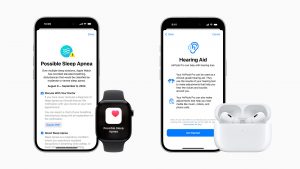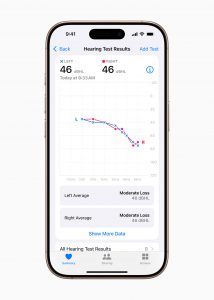Hearing loss has been called the ‘invisible disability’, one that can dramatically affect a person’s quality of life, as other disabilities do. Yet hearing health is often ignored (by society-at-large and the individual affected), and devices to aid in hearing often come with an ageist stigma attached.
As many as four million Canadians have some measurable hearing loss, and while hearing loss can be age-related, as many as 40 per cent of those four million are middle-aged, so it’s not just a senior’s issue. Among the causes of hearing loss, anything from accumulated ear wax to physical damage or impact, sudden or long-term exposure to loud sounds, diet and nutrition deficiencies, age and/or genetic factors and more.
Studies by audiologists show that many of those Canadians with a known degree of hearing loss don’t wear hearing aids even though their hearing could be improved. Cost is often a major barrier; physical and technical issues must be addressed, but there’s also a stigma still attached to those who need and use a hearing assistive device.
All of which are reasons why new rules (in the U.S., for now) that require all mobile phones – smartphones included – to be compatible with hearing aids is good news to hear. So, too, rules that now allow for over-the-counter (OTC) sales of hearing devices (again, in the U.S. for now). Usually much less expensive than prescribed hearing aid devices, over-the-counter models are not suitable for adults with severe hearing loss or for children.

Apple’s new health apps address hearing loss and sleep apnea.
Taking full advantage of such legislative changes, Apple has released its new AirPods with built-in health- and hearing-related features, including a hearing aid mode for people with a mild-to-moderate hearing loss.
Like other OTC hearing aids, it lets people with mild-to-moderate hearing loss function a bit better in challenging listening environments.
Technology in the best hearing aids will amplify and process incoming sounds, noises, speech and other sources. Multiple directional microphones are used to provide spatial and directional relevance to sound. Artificial intelligence algorithms are being used to differentiate among various audio sources and characteristics to highlight or make more audible needed or necessary sounds for those with hearing disabilities.

Apple’s Hearing Test results are used to process incoming sounds.
Apple has also introduced Active Hearing Protection, as the AirPod now has a built-in defence mechanism to reduce loud sounds and protect the ears. The feature is on by default and lowers volume of and exposure to loud noises, even as your music plays on.
There’s also a clinical-grade hearing test that can be self-taken by those with an iPhone or iPad running iOS 18. Apple says the Hearing Test and Hearing Aid are intended for people ages 18 or older, those with perceived mild-to-moderate hearing loss. After taking the roughly five-minute test, results — stored in the Apple Health app — are used by AirPods Pro 2 audio algorithms to make “personalized dynamic adjustments” to sound, boosting it in real-time to prescribed levels.
Apple’s Hearing Test and Hearing Aid features are “expected to receive marketing authorization from global health authorities soon”, the company stated, naming more than 100 countries and regions where authorization is expected, such as the U.S., Germany, and Japan – but not Canada.
In Canada, hearing aids aren’t yet available as OTC devices, as they are in the U.S. Hearing aids can be had here with a prescription issued by a licensed hearing professional. All such devices must also have approval from Health Canada.

Apple’s Active Hearing Protection in its updated AirPods reduces loud sounds and protects the ears.
However, the Hearing Protection feature is available in the U.S. and Canada, using AirPods Pro 2 paired with a compatible iPhone, iPad or Mac running iOS 18, iPadOS 18 and/or macOS Sequoia.
As encouraging as the smartphone and Apple hearing aid announcements have been, professional audiologists note that there are many types and degrees of hearing loss. And even with the cost-effective convenience of OTC and other audio assistive developments, the importance of proper testing and the services of a professional audiologist should not be ignored.
From initial testing to physical fitting to follow-up device adjustments, verification and counselling, the services and support from an audiologist are just as important as the hearing aid itself when dealing with someone’s hearing loss.
(A pair of prescribed assistive hearing devices in the U.S. or Canada can cost as much as $8,000 USD, services included. But listen to this: in the U.K., hearing aids are free from the National Health Service!).
Many of us regularly see the doctor for a physical, visit the dentist for a cleaning, go to the optometrist to get our eyes checked. But visiting the audiologist to get our ears tested, well, not so much.
But if every smartphone owner, every Apple user, can now conduct at least a basic hearing test with their own device, lots more people will be empowered to learn more about their hearing health and abilities and take action as needed.

-30-



